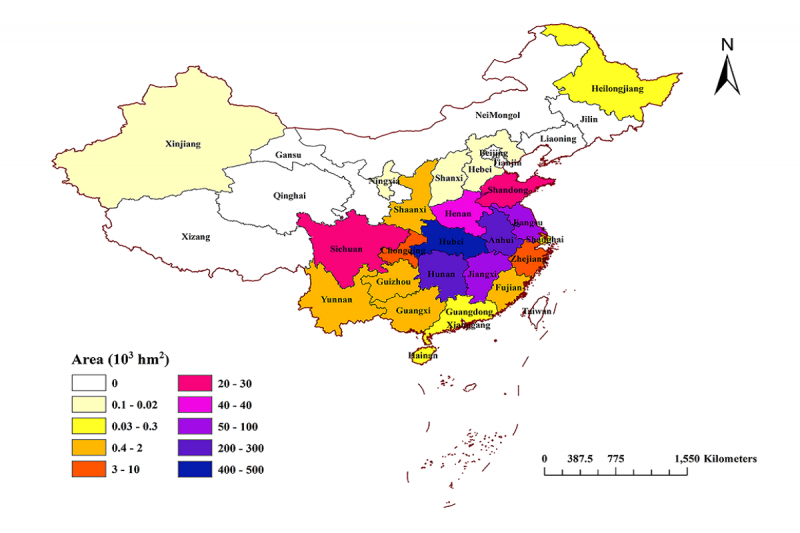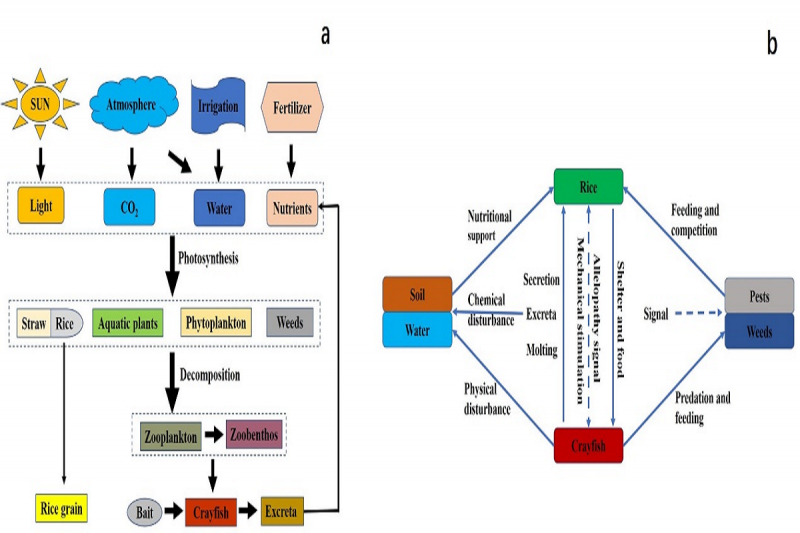您所在的位置:
近日,华中农业大学绿色植物科技进步学校生态农业科学研究精英团队发布具体描述,叙述了我国稻虾方式的进步小故事,全方位剖析了稻虾方式的室内环境绿色生态效用、经济发展效果和社会效应,明确提出了我国稻虾方式可持续发展观的工作原理与技术性对策。科研成果以“Crayfish–rice integrated system of production:An agriculture success story in China. A review”问题发布在Agronomy for Sustainable Development上。
图1 我国稻虾方式的范围遍布
农业已经寻找可持续发展的高产以处理食物难题。传统式的“高资金投入、高耗能”的现代农业生产模式给資源和自然环境提供了很大的压力。现阶段,我国已经促进农牧业生产过程向資源节省和绿色发展理念方位变化,近些年,稻虾综合性养殖方式因其明显的经济收益在中国取得了快速发展趋势。文中中,大家运用数据统计、参考文献,融合本精英团队很多年长期性精准定位实验科学研究結果,回望了稻虾综合性养殖方式在我国的发源和发展趋势,并将我国稻虾综合性养殖方式与全球其它地方的相近农牧业实体模型做好了较为,全方位具体描述剖析了稻虾综合性养殖方式在绿色生态、经济发展、社会发展层面的效用,便于对其实现理性点评,并得到了三个关键结果。最先,虽然最开始引入的龙虾来源于英国,但稻虾综合性养殖方式在我国的迅速进步使我国快速变成全球最大的龙虾生产的国家,我国的龙虾生产量占全球总产量的90%之上,变成龙虾生产加工和餐饮业的管理者。次之,我国独有的稻虾养殖方式推动了水稻种植向高品质、翠绿色制造系统的转型发展。最终,稻虾综合性养殖方式对水稻田系统软件的土壤环境品质、水份和营养物质循环系统、虫害限定和物种多样性发展趋势造成了积极主动危害。稻虾综合性养殖方式变成农业生产制造翠绿色转型发展的一个经典案例。根据上述剖析,文中指出了稻虾综合性养殖方式可持续发展观的绿色生态基本原理和技术性对策,这种結果也能为全球范畴内别的养殖系统软件的健康可持续发展观给予参照。
图2 稻虾方式可持续发展观基本原理与技术性对策
生态农业科学研究精英团队通过20很多年水稻田綜合养殖方式的科学研究,明确提出了水稻田綜合养殖绿色发展理念的思想体系,搭建了“双水双绿”稻虾、稻鸭综合性养殖方式,出版发行了《湖北省“双水双绿”产业发展战略研究》著作,发布有关探讨毕业论文34篇。
绿色植物科技进步学校生态农业精英团队江洋副教授职称为毕业论文第一创作者,曹凑贵专家教授为通讯作者。以上科学研究得到我国要点科研开发方案新项目和自然科学基金等工程的一同支助。
【英文摘要】
Chinese agriculture is seeking a sustainable production increase in order to solve the food problem for its population. The traditional “high input, high pollution” agricultural production mode has led to a large burden on resources and on the environment. At present, China is promoting the transformation of its agricultural production modes in the direction of resource conservation and green development. In recent years, the crayfish-rice integrated system of production (CRISP) has been developed intensively in China due to its important economic benefits. evaluating this new agricultural model comprehensively and guiding the related green sustainable development are urgent issues. Here we used statistical data and literature to review the origin and development of CRISP in China and to compare the Chinese CRISP with similar models in other parts of the world. We reviewed studies on the ecological and social effects of CRISP for its objective evaluation and drew three main findings. First, although the crayfish initially introduced were sourced from the United States, the extensive application of CRISP led China to rapidly become the largest crayfish producer worldwide — accounting for over 90% of the crayfish production — and a leader in crayfish processing and catering industries. Second, the specific Chinese CRISP culture model promotes a green transformation towards a high-quality rice production system. Finally, CRISP affected positively soil quality, water and nutrient recycling, pest limitation and biodiversity development in the paddy field system. CRISP reveals a good example of effective application of green revolution in China\’s agricultural production. We analyse for the first time the specific ecological foundation and management model for the sustainable development of CRISP. These observations provide reference for the development of other agriculture–livestock integrated systems worldwide.
毕业论文连接:https://link.springer.com/content/pdf/10.1007/s13593-021-00724-w.pdf
文章版权备注
文章版权归 郑州天顺食品添加剂有限公司 所有
文章链接:https://www.tsswhg.com/18904.html
未经授权,禁止任何站点镜像、采集、或复制本站内容,违者通过法律途径维权到底!
【推荐阅读】
- 2023-05-01奶味香精的制备技术与开发现状
- 2023-05-01菌种强化结合工艺优化提高酱香白酒基酒中四甲基吡嗪含量的研究(二)
- 2023-05-01发酵小麦胚芽产2,6-二甲氧基对苯醌菌种筛选及发酵条件优化(一)
- 2023-04-30茵栀黄化学成分及药理作用研究进展(一)
- 2023-04-04阿魏酸及其衍生物在食品添加剂领域研究进展(一)
- 2023-03-23“和美魏县,梨享天下”魏县鸭梨产业发展研讨会圆满落幕
- 2023-03-23关于参加山东食博会开幕式及餐饮高峰论坛的通知
- 2023-03-23超90%展商已确认展位 6月食品原料展带来海内外商机
- 2023-03-23关于召开2023年国际食品安全与健康大会的通知
- 2023-03-23白俄罗斯下调对中国等国家乳制品最低出口限价



 豫ICP备19024296号
豫ICP备19024296号 售前咨询
售前咨询